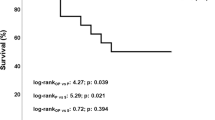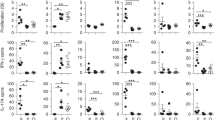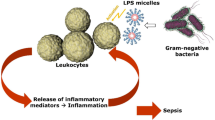Abstract
MANY non-specific immune phenomena have been described in which animals became resistant to experimental infection following administration of antigeni-cally unrelated materials. None has attracted more interest than the temporary state of enhanced resistance to infection with Gram-negative bacteria which develops in mice within hours after administration of antigenically unrelated bacterial endotoxins1. Among the many effects of endotoxins on the host is increased activity of the reticulo-endothelial system as shown by carbon clearance2 and by removal of phosphorus-32 labelled endotoxin3 or bacteria4. In addition, changes in the serum of endotoxin-treated animals have been reported, notably increased levels of properdin5, bactericidins6 and opsonins7,8. Passive transfer of opsonic capacity has also been demonstrated4. It is evident that these alterations in the host, individually or collectively, may contribute significantly to survival. Special emphasis has been placed on the nonspecific nature of the humoral factors involved, because there has been abundant confirmation of activity against bacterial strains antigenically unrelated to the endotoxin used for stimulation. Cross-reacting antibodies9 or a common antigen associated with the lipid complex of endotoxins10 have therefore been suggested to account for these observations.
This is a preview of subscription content, access via your institution
Access options
Subscribe to this journal
Receive 51 print issues and online access
$199.00 per year
only $3.90 per issue
Buy this article
- Purchase on Springer Link
- Instant access to full article PDF
Prices may be subject to local taxes which are calculated during checkout
Similar content being viewed by others
References
Shilo, M., Ann. Rev. Microbiol., 13, 255 (1959).
Biozzi, G., Benacerraf, B., and Halpern, B. N., Brit. J. Exp. Path., 36, 226 (1955).
Howard, J. G., Rowley, D., and Wardlaw, A. C., Immunol., 1, 181 (1958).
Benacerraf, B., Sebestyen, M. M., and Schlossman, S., J. Exp. Med., 110, 27 (1959).
Landy, M., and Pillemer, L., J. Exp. Med., 103, 823 (1956).
Rowley, D., Brit. J. Exp. Path., 37, 223 (1956).
Rowley, D., J. Exp. Med., 111, 137 (1960).
Jenkin, C. R., and Palmer, D. L., J. Exp. Med. 112, 419 (1960).
Lee, L., and Stetson, C. A., J. Exp. Med., 111, 761 (1960).
Benacerraf, B., and Miescher, P., Ann. N.Y. Acad. Sci., 88, 184 (1960).
Landy, M., Michael, J. G., and Whitby, J. L. (in preparation).
Author information
Authors and Affiliations
Rights and permissions
About this article
Cite this article
MICHAEL, J., WHITBY, J. & LANDY, M. Increase in Specific Bactericidal Antibodies after Administration of Endotoxin. Nature 191, 296–297 (1961). https://doi.org/10.1038/191296a0
Issue Date:
DOI: https://doi.org/10.1038/191296a0
This article is cited by
-
Effect of bacterial polysaccharide on the number of antibody-producing cells in the spleen of irradiated and unirradiated mice
Bulletin of Experimental Biology and Medicine (1974)
-
Contribution of Endotoxin to Antibody Formation against T2 Phage
Nature (1969)
-
Der Einflu� des Lipopolysaccharids (Salmonella typhi murium) auf die Bildung von Antik�rpern gegen Diphtherie und Tetanus bei Kindern im ersten Lebensjahr
Zeitschrift f�r Kinderheilkunde (1964)
-
Development of bactericidal properties against gram-negative organisms in the serum of young animals
Folia Microbiologica (1962)
Comments
By submitting a comment you agree to abide by our Terms and Community Guidelines. If you find something abusive or that does not comply with our terms or guidelines please flag it as inappropriate.



